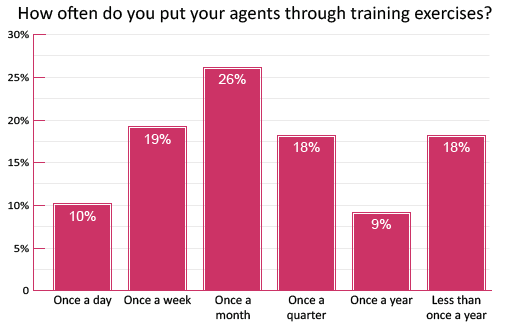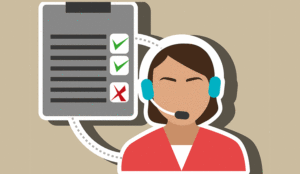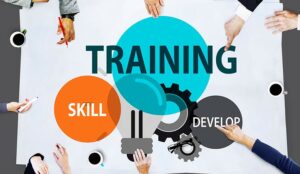Our panel of experts share some practical strategies for making time for agent training in the contact centre – even if you think you’re too busy.
Agents will retain more information if it is delivered in smaller chunks
Training can feel like an endurance test for presenters and agents alike. This is often because too much is being crammed into one session (“make the most of that precious training room time!”) or because only a fraction of the content is relevant to the audience (“wake up at the back!”).
If you break training into bite-sized pieces, agents will retain more information and it has less of an impact in terms of scheduling, ensuring that customer service levels are not compromised.
Automate time-consuming processes to make more time for training
To make the biggest impact, look not at how you deliver training but at everything else going on around you.
Question everything. Why are we tracking this process on a spreadsheet? Why are agents still dual-keying this information? Why do supervisors have to wait so long to understand the performance of their team? Why are holiday requests still managed by email?

Adam Thorn
Allow agents to ask questions to ensure maximum benefit
Make sure you provide mechanisms to allow agents to ask questions and encourage them to provide constructive feedback on the training itself.
Also keep training content varied, make the objectives clear, ensure that the visual content is stimulating, and keep the tone of presenters varied and peppered with interesting examples and anecdotes.
With thanks to Adam Thorn at NICE Systems
‘Power hour’ sessions are a viable alternative to a full day off the phones
It can be a ‘Catch 22’ situation when it comes to making time for front-line training. Without it, your agents will take longer on calls, but taking them out for training when customers are waiting seems counter-intuitive.

Carolyn Blunt
It has to be short-term pain for long-term gain, though!
We are increasingly being asked to do ‘Power Hour’ sessions, half days and e-learning which ranges from 5-minute to 1-hour blocks.
While these are great alternatives, the ‘fix’ of a one-day workshop in boosting agent skills, morale and motivation should not be forgotten.
A treasured break from the norm, if done correctly, training can have a memorable and lasting effect. This can impact absence, retention and performance.
With thanks to Carolyn Blunt at Real Results Training
Block out time for training when you typically experience low connect rates
Use integrated WFM tools to calculate the best time of day and day of the week to run training based on your peaks and troughs.
Block out time for training when you typically experience low connection rates for outbound or for inbound teams when you are likely to receive fewer incoming calls/chats/email enquiries etc.
Just be careful not to schedule the training for those times when the agents may be ‘frazzled’. For example, at the end of a long day.
Automate your training and coaching tools
If you feel you really can’t make the time, automate your training processes as much as possible.
You can use objective grading and coaching tools to obtain agent scores and run coaching sessions.

Mike Donohue
Set this to automatically identify weaknesses or areas that need to be approved. For example, where an agent falls below the average of their peers or where there is a score below a threshold assigned to a specific question or template.
Then have this automatically trigger e-learning course modules to agent desktops, either during idle time or as an ongoing weekly training schedule.
You can also use flexible web-based reporting to view quality performance information – for either teams or individuals and continue this cycle of learning as appropriate.
With thanks to Mike Donohue at Magnetic North

A poll of 482 Call Centre Helper readers in August 2015 revealed that 26% of agents receive training just once a month.
Use real-time management to give instant feedback
If your contact centre technology integrates with a CRM system and you benefit from call recording and real-time management dashboards, you can give agents instant feedback.
Instead of waiting until a review or any other time where you’re officially “checking in” with an agent, it’s often better to give feedback as you go, so they can act on it straight away and ensure they’re always learning and developing.
Plus, you can make adjustments to processes as and when needed, giving your team greater flexibility as well as more guidance if needed. It’s also important to remember that real-time coaching is more effective because it’s rooted in the job itself.
With thanks to Jonathan Gale at NewVoiceMedia
Side-by-side training can be stopped and started between customer contacts
Provide different methods for training – in addition to traditional classroom delivery.
Side-by-side one-to-one training can be an effective way to use idle/wait time, along with using online training modules.
In both these instances it is important that the training is suitable to be stopped and started around customer contacts.

Phil Anderson
Allocate budget for training and development activities
Allocate time for training and development into your annual budget – just don’t flat line this across the year thinking all months will be the same.
By first understanding the volatility and predictability of your customer contacts, you can consider a shrinkage percentage for training and development.
Training can’t be added in after your budget headcount has been agreed, thinking that it will be possible to use a mixture of idle time and quiet periods.
With thanks to Phil Anderson at The Forum
Listen and learn from your sales and service ‘superstars’

Jeremy Payne
Using the latest real-time speech analytics (RTSA) management tools, you can listen in and learn the key phrases that your ‘superstar’ sales and service people use to sell more and achieve optimum customer satisfaction feedback ratings.
Having deciphered ‘the code’ and worked out what those key phrases are, you can then build them into your training plan and customer engagement strategy and ensure all agents use those same phrases.
Speech analytics tools can also prompt your agents to adhere to the buzzwords when interacting with customers.
With thanks to Jeremy Payne at Enghouse Interactive
A detailed training plan will help you deliver effective, impactful sessions
A well-developed and detailed training plan will help you to prepare and deliver effective, impactful training sessions with clear instruction in a concise way.
A good place to start is to identify the goal. What is the purpose of the training and how will you achieve the most effective outcome? Think about how to measure how effective the training has been. Understand your timeline – how long do you have to conduct training, how long will it take, is it a group session, one-on-one or a combination of the two?
Consider any resources you may need for each step of training, such as materials and equipment, and ensure they are easily available. It is also important that you dedicate time to carefully planning your training sessions. In doing so you will maximise the value participants get from them.
Create a buddy programme
If you’re struggling to make time for training but have identified areas for improvement across teams, look at creating a buddy programme by pairing team leaders or high-performing agents with those that need development.
Not only does this empower individuals in the contact centre, but it strengthens bonds and creates a culture of knowledge sharing. This is also a great way of further developing high-performing individuals.
Engage your agents in the importance of training
Ensure that all participants are aware of when and where the training will take place as well as what the training is about.

Michelle Dinsmore
There’s nothing worse than getting people in a room and asking for their understanding of why they are there only to be told ‘Because my manager told me.’
Uncertainty can have a negative impact in the call centre and agents often think that things are happening because they’ve done something wrong.
Promptly reschedule training
If you have to cancel agent training for any reason, make sure you promptly reschedule in order to show you’re committed to the development of the team.
With thanks to Michelle Dinsmore at EvaluAgent
Integrated e-learning tools can make good use of idle time
Providing dedicated e-learning that can be integrated into classroom training, while also remaining self-paced for agents’ convenience, reduces agents’ time away from dealing with customers.
It can also be undertaken during time that otherwise would be unproductive. Look for a comprehensive cloud-learning programme to educate and increase your agents’ skills.
This can result in improved contact centre productivity by reducing call duration, increasing the overall number of processed contacts and improving first call resolution.
With thanks to Chris Dealy at injixo
Provide additional training outside core hours
The most obvious way to make time for agent training is to provide additional training outside core hours, or increase staffing resources in order to allow some time off the phone.
Having said this, however, this will then increase contact centre costs, which is not always possible with the tightening of budgets.
Quality monitoring can help identify the skills gaps you need to focus on
In a limited-resources scenario, the key is to deliver the right training to the right people at the right time.
Using quality monitoring statistics and reports can help establish agent knowledge and skills gaps.
By using this information effectively, you can ensure the right training is being designed and delivered to the agents who need it the most – not wasting time on those who don’t.
Give agents access to their own call recordings

Brent Bischoff
Using agent call recordings also provides a simple training method. Allowing agents access to the own telephone calls from their desktop provides a quick and simple self-evaluation and training process.
Quick training sessions can be incorporated into team meetings by listening to a sample of customer calls. This then allows the team to share best practice, learn from each other’s experiences and fill in knowledge gaps.
Training doesn’t have to be restricted to the classroom. Quick, fast, on-the-job training can be delivered effectively from the agent’s workstation, without being a large business expense or taking time away from core operations.
With thanks to Brent Bischoff at Business Systems
Build training requirements into your annual shrinkage plan
Ensure that the resource planners build training requirements, however modest, into your annual shrinkage plan.
This means you can ensure that you have capacity to deliver the training and that, equally importantly, it avoids peak business and holiday times. Planning in advance creates the opportunity for training to occur and it becomes a scheduled versus an ad hoc event.
Perhaps ask:
- What are the key training requirements? The ‘must deliver’, ‘essential for some agents’ and ‘nice to have’ for all
- Ask the training department and the operations managers for a rolling 12-month view of training requirements and budget monthly
- The ‘unknown’ that catches us by surprise. Consider last year’s events and factor in the same number of unexpected events. For example, if there were two emergency system training sessions, replicate them in this year’s plan
- Request that the planners schedule a minimum of ‘must deliver’ and ‘essential’ training for your team and calculate the necessary shrinkage
- ‘Nice to have’ training could then be accommodated within team meeting time or 1-2-1s as needed
Having a structured plan ensures that time is provided and that, when emergencies occur, substitutions can be made and anticipated training can be rescheduled for the next month.
Optimise breaks and lunch to create space for emergency training sessions

Lynley Meyers
In the event of a training emergency, consider the mechanisms available in your workforce planning tool to optimise your shifts or plan 1-2-1 meetings.
Also evaluate forecast demand for the target dates and choose a useful time without anticipated peaks.
Use the intelligence in your planning tool to optimise breaks and lunch and create space to accommodate an emergency training session without impacting your service levels.
- You may need to repeat training to several smaller groups
- Move shifts by up to an hour to flex your capacity, or change break times
- You may find using a call-back facility provides you with flexibility and peace of mind, allowing you to capture caller details and maintain customer satisfaction. Once you are all back at your workstations you can call the customers back and recover any slippage.
Whatever your method – stick to the programme, it will deliver value. Staff need to feel valued. An agent’s self-confidence and morale improves when they have the information they need to perform their tasks well.
With thanks to Lynley Meyers at Netcall
Detailed profiling helps to assess agents’ strengths and weaknesses
We have done detailed profiling of the agents and established a detailed propensity to sell of each agent, meaning that the strengths and weaknesses can be clearly defined.
Allocated training programmes can then be designed specific to each agent and therefore be less time consuming and more cost effective.
With thanks to Charl du Mont
‘Lunch and Learn’ training
‘Lunch and Learn’ or ‘Breakfast and Learn’ events incentivise agents to give up their lunch break (or come in early) for training exercises.
With thanks to Jacqueline Bradney
How do you make time for agent training in your contact centre? Have you tried any of the above?
Author: Megan Jones
Published On: 21st Oct 2015 - Last modified: 18th Aug 2025
Read more about - Call Centre Management, Brent Bischoff, Business Systems, Carolyn Blunt, Chris Dealy, Employee Engagement, Enghouse Interactive, EvaluAgent, Intrado, Jeremy Payne, Jonathan Gale, Management Strategies, NiCE, Peopleware, Phil Anderson, The Forum, Training and Coaching, Vonage










































Excellent tips here! It’s important to make sure your agents are well-trained and understand what they’re doing. The time investment is worth it for better quality employees.
Keeping it real and relevant is important. Never under estimate the power of a great one to one coaching session, at the advisor’s desk!
This is the ideal solution for helping develop great sales and amazing customer service skills, whilst reducing time away from the desk.
Great advice. I would like to add that,Agents can understand their mistakes better if they listen to a call made by experienced agents. This way when hearing their own interactions about a similar issue , they can see where the experienced agent was able to handle the customer in a better manner. So the next time the agent faces a similar condition he is prepared to tackle it.